NVIDIA's GeForce GTX 550 Ti: Coming Up Short At $150
by Ryan Smith on March 15, 2011 9:00 AM ESTPower, Temperature, & Noise
Last but not least as always is our look at the power consumption, temperatures, and acoustics of the GTX 550 Ti. As a result NVIDIA’s tinkering with both power efficiency and clocks, performance has gone way up but power has also gone up too: the official TDP has gone up by 10W.
Please note that as we don’t have a true reference card our testing methodology has been slightly tweaked. We’ve tested the AMP at both GTX 550 Ti reference clocks and at its factory overclock for all metrics, however noise and temperature in particular are going to significantly vary from manufacturer to manufacturer.
| GeForce GTS 450 & GTX 550 Voltage | ||||
| GTS 450 | Zotac GTX 550 Ti Amp | Idle | ||
| 1.05v | 1.1525v | 0.95v | ||
The load voltage on our Zotac AMP is 1.1525v, which compared to GF106/GTS 450 ends up being quite high. No doubt Zotac has given the card some more voltage to handle the factory overclock, however this will also skew our power results for load. Idle however remains unchanged at 0.95v.
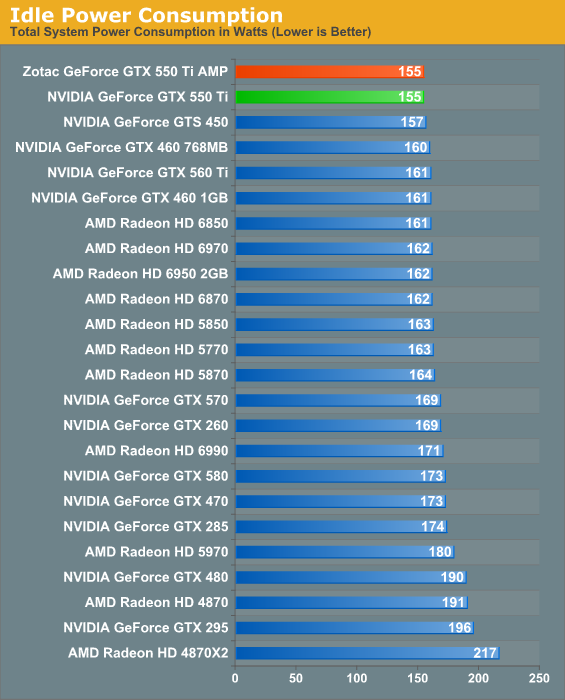
Right off the bat, idle power consumption looks good. At 155W the Zotac GTX 550 AMP beats even the reference GTS 450 by 2W, and the gap with the Radeons is much larger. Here we’re looking at a 6W advantage over the 6850, and 8W over the 5770. This is no small feat given how hard it is to reduce idle power usage, and showcases the benefits of NVIDIA’s transistor tinkering.
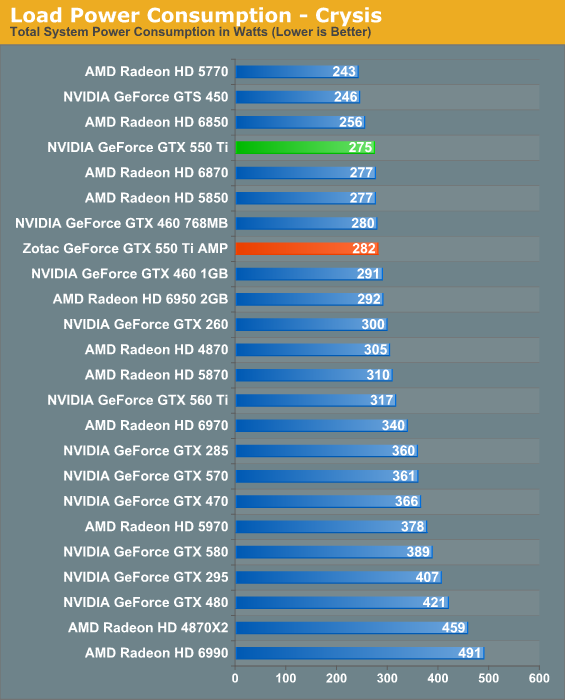
Power consumption leaves much to be desired however, and it’s at this point that we can’t easily separate the GTX 550 Ti from the Zotac GTX 550 AMP. If the Zotac card did not have an overclock, perhaps it would have a lower load voltage, and as such lower power draw under load. But in this case it does not, which leads to a total system power draw difference of 19W over the 6850, never mind the 5770.
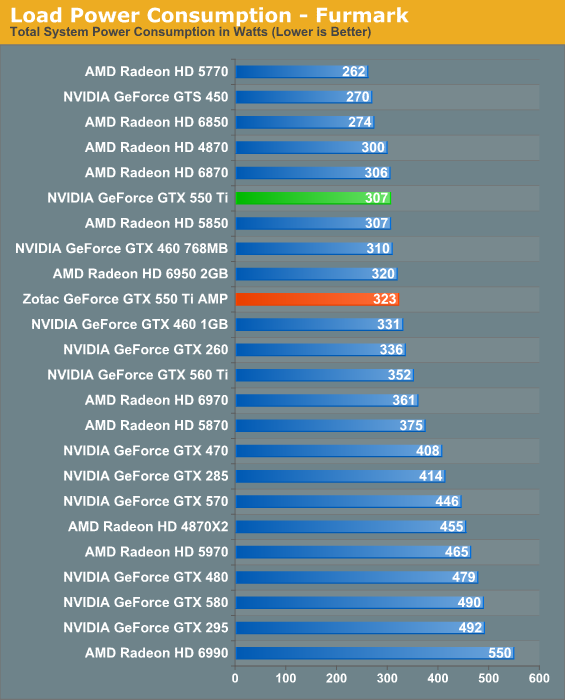
The GTX 550 Ti does not have any kind of overcurrent protection like the rest of the GTX 500 series, so here we can get straight numbers without forcibly disabling it. The results, like with Crysis, are understandably poor for the card; 33W over the 6850, more for the card when it’s running at factory clocks. If a more reference style GTX 550 Ti is anything like this, it bodes poorly for the card compared to the already faster 6850.
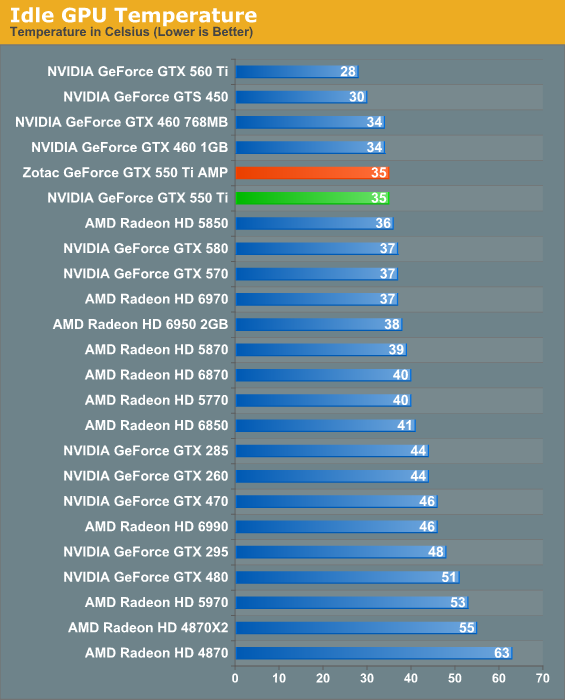
The king of our idle temperature charts is composed of NVIDIA reference cards, and while the Zotac GTX 550 AMP gives a decent performance, it can’t keep up. 35C at idle is still quite good, but we saw better on the GTS 450, and would likely see something similar on a reference GTX 550 Ti.
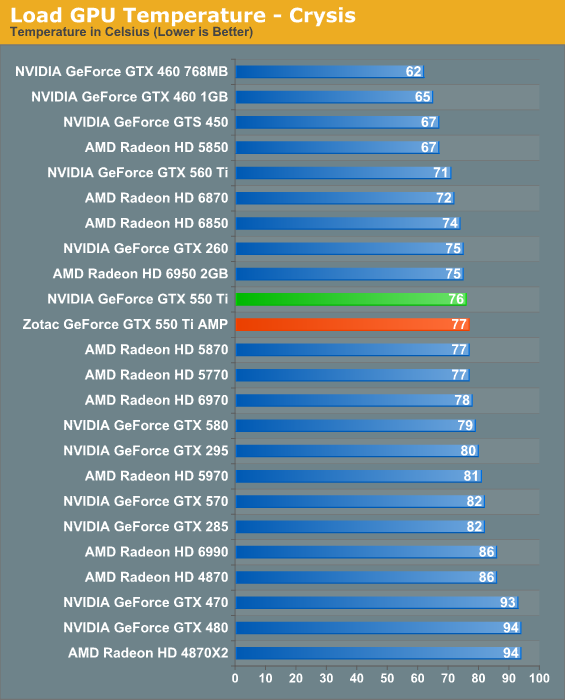
Under load, temperatures end up being middle the road, thanks once more to the card’s higher power consumption. Funny enough it does beat the 5770 by 1C even after all of this, but one could just as well slap the GTX 460 cooler on here and get results that would undoubtedly be below 70C.
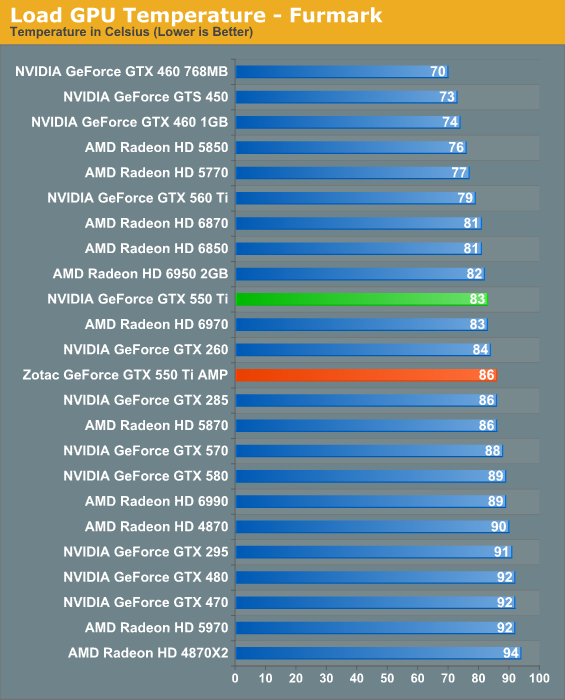
FurMark of course adds several C more to our temperatures. In fact for a lower power card like the Zotac GTX 550 AMP we’re actually caught a bit off-guard. 86C at factory clocks means there’s some thermal headroom to play with for overclocking, but not too much – the GTX 550 Ti’s max temperature is only 95C.
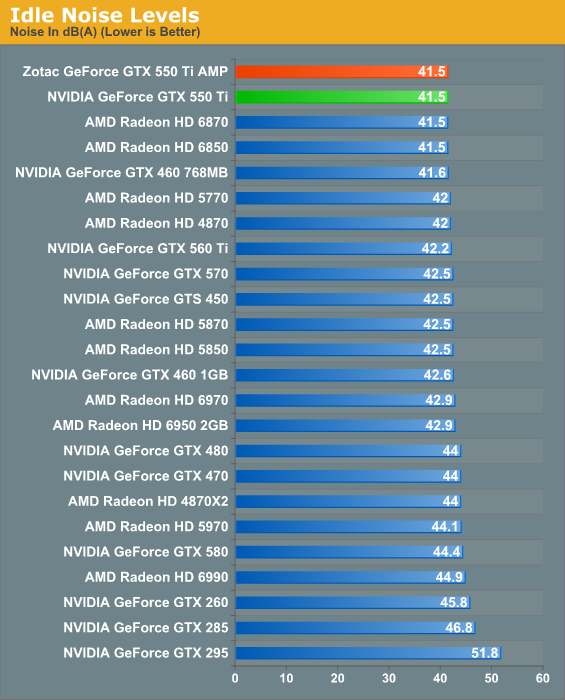
For cards in this performance category, idle noise is pretty consistent thanks to the common use of open coolers. The Zotac GTX 550 AMP doesn’t disappoint here, offering a practically silent 41.5dbA as measured by our meter.
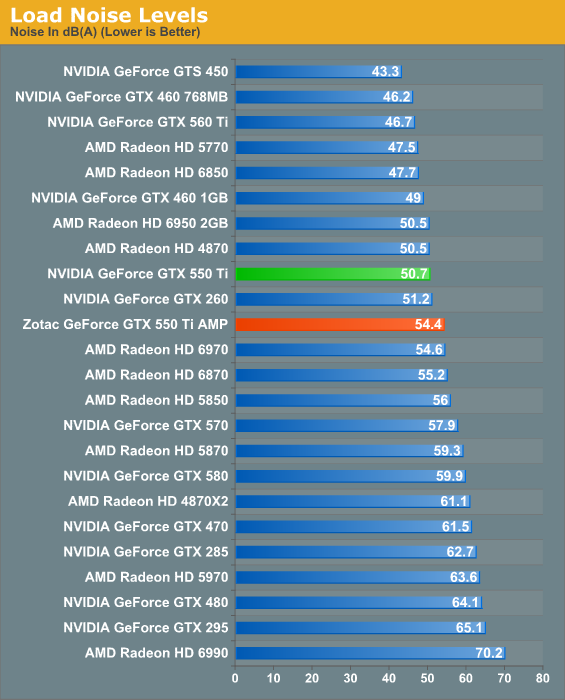
If you were hoping that higher temperatures would be a precursor to lower fan noise, you’re going to come up empty handed here. 50.7 is by no means loud among all the cards we’ve tested, but we’ve seen better. In fact the 5770/6850 both do better, as does the GTX 460 and GTX 560. At the AMP’s full factory overclock we get up to 54.4dbA, which is certainly going to be noticeable. Unfortunately the card doesn’t have the performance even with the overclock to justify the noise.
Ultimately this is less a discussion of the GTX 550 Ti reference design, and more a discussion on the Zotac GTX 550 Ti AMP’s design, which more likely than not takes a hit in cooling and temperatures thanks to the 2nd DVI port partially blocking the card’s external exhaust. But for the time being, it’s what we have to work with.










79 Comments
View All Comments
Ryan Smith - Tuesday, March 15, 2011 - link
Our experience with desktop Linux articles in the past couple of years is that there's little interest from a readership perspective. The kind of video cards we normally review are for gaming purposes, which is lacking to say the least on Linux. We could certainly try to integrate Linux in to primary GPU reviews, but would it be worth the time and what we would have to give up in return? Probably not. But if you think otherwise I'm all ears.HangFire - Tuesday, March 15, 2011 - link
All I'm asking for is current and projected CUDA/OpenCL level support, and what OS distro's and revisions are supported.You may not realize it, but all this GPGPU stuff is really used in science, government and defense work. Developers often get the latest and greatest gaming card and when it is time for deployment, middle end cards (like this one) are purchased en masse.
Nividia and AMD have been crowing about CUDA and OpenCL, and then deliver spotty driver coverage for new and previous generation cards. If they are going to market it heavily, they should cough up the support information with each card release, we shouldn't have to call the corporate rep and harangue them each and every time.
Belard - Wednesday, March 16, 2011 - link
Someone who already has a GF450 would be a sucker to spend $150 for a "small-boost" upgraded card.When upgrading, a person should get a 50% or better video card. A phrase that never applies to a video card is "invest" since they ALL devalue to almost nothing. Todays $400~500 cards are tomorrows $150 cards and next weeks $50.
So a current GF450 owner should look at a GF570 or ATI 6900 series cards for a good noticeable bump.
mapesdhs - Wednesday, March 16, 2011 - link
Or, as I've posted before, a 2nd card for SLI/CF, assuming their mbd
and the card supports it. Whether or not this is worthwhile and the
issues which affect the outcome is what I've been researching in recent
weeks. Sorry I can't post links due to forum policy, but see my earlier
longer post for refs.
Ian.
HangFire - Friday, March 18, 2011 - link
I wasn't really suggesting such an upgrade (sidegrade). I was just saying that each generation card at a price point and naming convention (450->550) should have at least a little better performance than card it replaces.Calabros - Tuesday, March 15, 2011 - link
tell me a reason to NOT prefer 6850 over this7Enigma - Tuesday, March 15, 2011 - link
So basically this is my 4870 in a slightly lower power envelope with DX11 features. I'm shocked the performance is so low honestly. Thanks for including the older cards in the review because it's always nice to see I'm still chugging along just fine at my gaming resolution (1280X1024) 19".7Enigma - Tuesday, March 15, 2011 - link
Forgot to add, which I bought in Jan 2009 for $180 (Sapphire Toxic 512meg VaporX, so not reference design)mapesdhs - Tuesday, March 15, 2011 - link
You're the target audience for the work I've been doing, comparing cards at
that kind of resolution, old vs. new, and especially where one is playing older
games, etc. Google for, "Ian PC Benchmarks", click the 1st result, then select,
"PC Benchmarks, Advice and Information". I hope to be able to obtain a couple
of 4870s or 4890s soon, though there's already a lot of 4890 results included.
Ian.
morphologia - Tuesday, March 15, 2011 - link
Why in the name of all that's graphical would you use this Noah's Ark menagerie of cards but leave out the 4890? It doesn't make sense. If you're going to include 4000 series cards, you must include the top-of-the-line single-GPU card. It's proven to be quite competitive even now, against the lower-level new cards.